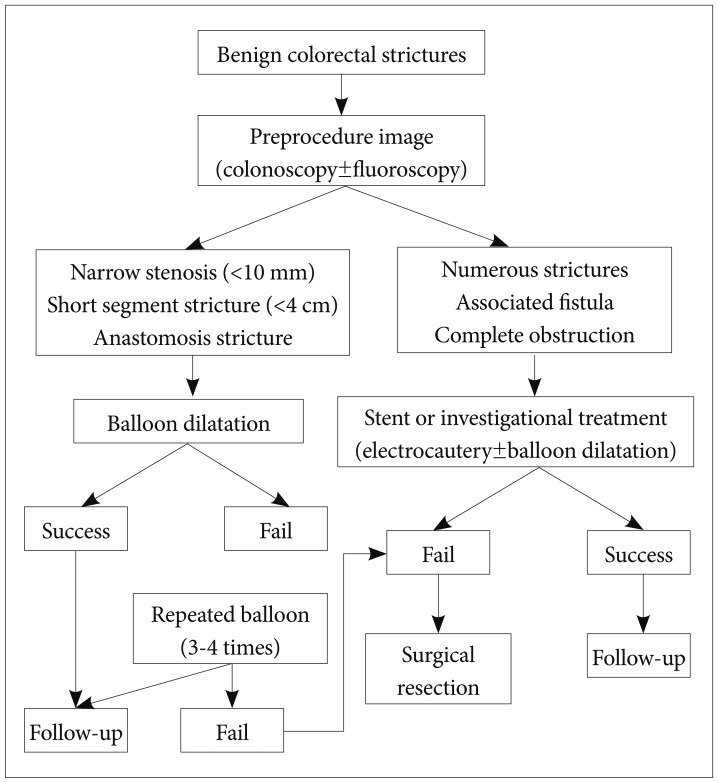Clin Endosc.
2013 Sep;46(5):472-475.
Endoscopic Management of Refractory Benign Colorectal Strictures
- Affiliations
-
- 1Department of Internal Medicine, Kyungpook National University Hospital, Kyungpook National University School of Medicine, Daegu, Korea. swjeon@knu.ac.kr
- 2Department of Internal Medicine, Dongguk University College of Medicine, Gyeongju, Korea.
Abstract
- In colonoscopic study, benign colorectal strictures with or without symptomatic pain are not rarely encountered. Benign colorectal stricture can be caused by a number of problems, such as anastomotic stricture after surgery, inflammatory bowel disease, postendoscopic submucosal dissection, diverticular disease, ischemic colitis, and so on. There are various modalities for the management of benign colorectal stricture. Endoscopic balloon dilatation is generally considered as the primary treatment for benign colorectal stricture. In refractory benign colorectal strictures, several treatment sessions of balloon dilatation are needed for successful dilatation. The self-expandable metal stent and many combined techniques are performed at present. However, there is no specific algorithmic modality for refractory benign colorectal strictures.
MeSH Terms
Figure
Reference
-
1. Garcea G, Sutton CD, Lloyd TD, Jameson J, Scott A, Kelly MJ. Management of benign rectal strictures: a review of present therapeutic procedures. Dis Colon Rectum. 2003; 46:1451–1460. PMID: 14605561.2. Suchan KL, Muldner A, Manegold BC. Endoscopic treatment of postoperative colorectal anastomotic strictures. Surg Endosc. 2003; 17:1110–1113. PMID: 12728381.
Article3. Lemberg B, Vargo JJ. Balloon dilation of colonic strictures. Am J Gastroenterol. 2007; 102:2123–2125. PMID: 17897332.
Article4. Breysem Y, Janssens JF, Coremans G, Vantrappen G, Hendrickx G, Rutgeerts P. Endoscopic balloon dilation of colonic and ileo-colonic Crohn's strictures: long-term results. Gastrointest Endosc. 1992; 38:142–147. PMID: 1568610.
Article5. Bonin EA, Baron TH. Update on the indications and use of colonic stents. Curr Gastroenterol Rep. 2010; 12:374–382. PMID: 20703837.
Article6. Mueller T, Rieder B, Bechtner G, Pfeiffer A. The response of Crohn's strictures to endoscopic balloon dilation. Aliment Pharmacol Ther. 2010; 31:634–639. PMID: 20047581.
Article7. Liangpunsakul S, Rex DK. Management of benign colonic strictures. Tech Gastrointest Endosc. 2003; 5:178–181.
Article8. Tsereteli Z, Sporn E, Geiger TM, et al. Placement of a covered polyester stent prevents complications from a colorectal anastomotic leak and supports healing: randomized controlled trial in a large animal model. Surgery. 2008; 144:786–792. PMID: 19081022.
Article9. Forshaw MJ, Sankararajah D, Stewart M, Parker MC. Self-expanding metallic stents in the treatment of benign colorectal disease: indications and outcomes. Colorectal Dis. 2006; 8:102–111. PMID: 16412069.
Article10. Vanbiervliet G, Bichard P, Demarquay JF, et al. Fully covered self-expanding metal stents for benign colonic strictures. Endoscopy. 2013; 45:35–41. PMID: 23136012.
Article11. Saito Y, Tanaka T, Andoh A, et al. Novel biodegradable stents for benign esophageal strictures following endoscopic submucosal dissection. Dig Dis Sci. 2008; 53:330–333. PMID: 17713855.
Article12. Saito Y, Tanaka T, Andoh A, et al. Usefulness of biodegradable stents constructed of poly-l-lactic acid monofilaments in patients with benign esophageal stenosis. World J Gastroenterol. 2007; 13:3977–3980. PMID: 17663513.
Article13. Pérez Roldán F, González Carro P, Villafáñez García MC, et al. Usefulness of biodegradable polydioxanone stents in the treatment of postsurgical colorectal strictures and fistulas. Endoscopy. 2012; 44:297–300. PMID: 22261748.
Article14. Repici A, Pagano N, Rando G, et al. A retrospective analysis of early and late outcome of biodegradable stent placement in the management of refractory anastomotic colorectal strictures. Surg Endosc. 2013; 27:2487–2491. PMID: 23443478.
Article15. Truong S, Willis S, Schumpelick V. Endoscopic therapy of benign anastomotic strictures of the colorectum by electroincision and balloon dilatation. Endoscopy. 1997; 29:845–849. PMID: 9476768.
Article16. Curcio G, Spada M, di Francesco F, et al. Completely obstructed colorectal anastomosis: a new non-electrosurgical endoscopic approach before balloon dilatation. World J Gastroenterol. 2010; 16:4751–4754. PMID: 20872979.
Article17. Dafnis G. A novel technique for endoscopic reanastomosis in a patient with a completely strictured colorectal anastomosis. Endoscopy. 2008; 40(Suppl 2):E79–E80. PMID: 18633899.
Article18. Wolthuis AM, Rutgeerts P, Penninckx F, D'Hoore A. A novel hybrid technique using transanal endoscopic microsurgery and balloon dilation in the treatment of a benign complete colorectal anastomotic stricture. Endoscopy. 2011; 43(Suppl 2 UCTN):E176–E177. PMID: 21557155.
Article19. Sutton CD, Marshall LJ, White SA, Flint N, Berry DP, Kelly MJ. Tenyear experience of endoscopic transanal resection. Ann Surg. 2002; 235:355–362. PMID: 11882757.
Article
- Full Text Links
- Actions
-
Cited
- CITED
-
- Close
- Share
- Similar articles
-
- Benign Esophageal Stricture
- Endoscopic Diagnosis and Treatment of Benign Biliary Strictures
- Management of Benign and Malignant Pancreatic Duct Strictures
- Endoscopic Management of Benign Pancreatic Stricture Associated with Chronic Pancreatitis
- Update of endoscopic management of Crohn’s disease strictures


